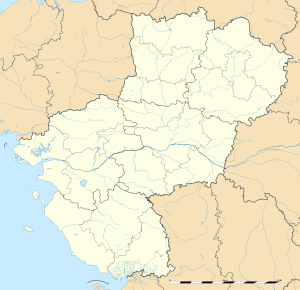Aubigné-Racan
| Aubigné-Racan | |
|---|---|
|
The ruins of the theatre | |
 Aubigné-Racan | |
|
Location within Pays de la Loire region  Aubigné-Racan | |
| Coordinates: 47°41′29″N 0°16′07″E / 47.6914°N 0.2686°ECoordinates: 47°41′29″N 0°16′07″E / 47.6914°N 0.2686°E | |
| Country | France |
| Region | Pays de la Loire |
| Department | Sarthe |
| Arrondissement | La Flèche |
| Canton | Mayet |
| Intercommunality | Aune et Loir |
| Government | |
| • Mayor (2001–2008) | Michel Royer |
| Area1 | 32.03 km2 (12.37 sq mi) |
| Population (2006)2 | 2,114 |
| • Density | 66/km2 (170/sq mi) |
| Time zone | CET (UTC+1) |
| • Summer (DST) | CEST (UTC+2) |
| INSEE/Postal code | 72620 / 72800 |
| Elevation |
37–118 m (121–387 ft) (avg. 31 m or 102 ft) |
|
1 French Land Register data, which excludes lakes, ponds, glaciers > 1 km² (0.386 sq mi or 247 acres) and river estuaries. 2 Population without double counting: residents of multiple communes (e.g., students and military personnel) only counted once. | |
Aubigné-Racan is a commune in the Sarthe department in the region of Pays-de-la-Loire in north-western France.
Sights
The town has a Romanesque church from the 11th century.
Aubigné-Racan is the site of the archeological excavation of Cherré, a Gallo-Roman complex of 20 hectares from the 1st to the 3rd centuries. The site was likely a rural centre of commercial and religious activity before the Roman conquest. Excavations in 1977 by C. Lambert and J. Rioufreyt discovered an ancient theatre, two temples, Roman thermae, a forum and an aqueduct.
In the surrounding countryside, one can also find prehistoric standing stones, or dolmens ("dolmen de la Pierre" and "dolmen du Colombier").
People
Aubigné-Racan is the birthplace of the 17th century poet and dramatist Honorat de Bueil, seigneur de Racan. His birthplace, the Manoir de Champmarin, is still standing.
See also
References
| Wikimedia Commons has media related to Aubigné-Racan. |
